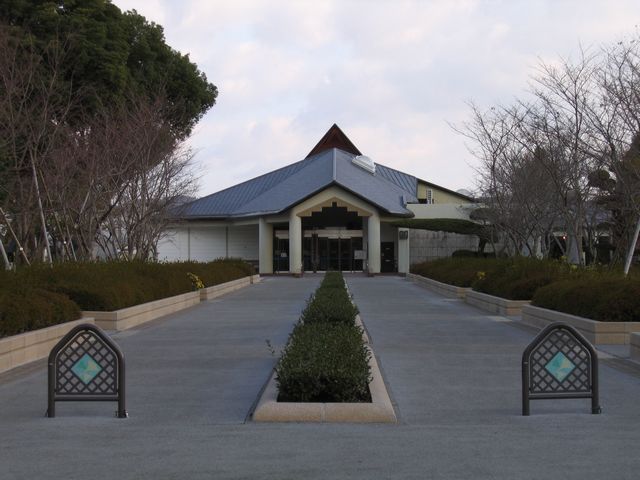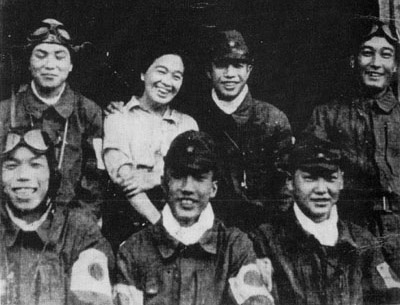|
Chiran Peace Museum For Kamikaze Pilots
The airbase at Chiran, Minamikyūshū, on the Satsuma Peninsula of Kagoshima, Japan, served as the departure point for hundreds of Special Attack or kamikaze sorties launched in the final months of World War II. A peace museum dedicated to the pilots, the , now marks the site. Airbase The Chiran Airfield operated by the Imperial Japanese Army at Chiran, Kagoshima, with its two runways, was the principal base of the kamikaze pilots during the Battle of Okinawa. Of the 1,036 army aviators who died in these attacks, 439 were from Chiran. Of the total number, 335 were classed as "young boy pilots" (少年飛行兵). Peace Museum In 1975 a museum was built to commemorate the lives of the pilots and document their "patriotic efforts for peace". Enlarged in 1985, exhibits include four planes: a Nakajima Ki-43 Hayabusa, a 1943 Kawasaki Ki-61 Hien, a 1944 Nakajima Ki-84 Hayate, and a Mitsubishi Zero recovered from the seabed in 1980. On a personal level, the exhibit includes lett ... [...More Info...] [...Related Items...] OR: [Wikipedia] [Google] [Baidu] |
Nakajima Ki-43 Hayabusa
The Nakajima Ki-43 ''Hayabusa'' (, "Peregrine falcon"), formal Japanese designation is a single-engine land-based tactical Fighter aircraft, fighter used by the Imperial Japanese Army Air Service in World War II. The Allied World War II Allied names for Japanese aircraft, reporting name was "Oscar", but it was often called the "Army Zero" by American pilots because it bore a certain resemblance to the Mitsubishi A6M Zero, the Imperial Japanese Navy's counterpart to the Ki-43. Both aircraft had generally similar layout and lines, and also used essentially the same Nakajima Sakae radial engine, with similar round cowlings and Bubble canopy, bubble-type canopies (the ''Oscar''s being distinctly smaller and having much less framing than the A6M). While relatively easy for a trained eye to tell apart with the "finer" lines of the Ki-43's fuselage – especially towards the tail – and more tapered wing planform, in the heat of battle, given the brief glimpses and distraction of com ... [...More Info...] [...Related Items...] OR: [Wikipedia] [Google] [Baidu] |
Time (magazine)
''Time'' (stylized in all caps as ''TIME'') is an American news magazine based in New York City. It was published Weekly newspaper, weekly for nearly a century. Starting in March 2020, it transitioned to every other week. It was first published in New York City on March 3, 1923, and for many years it was run by its influential co-founder, Henry Luce. A European edition (''Time Europe'', formerly known as ''Time Atlantic'') is published in London and also covers the Middle East, Africa, and, since 2003, Latin America. An Asian edition (''Time Asia'') is based in Hong Kong. The South Pacific edition, which covers Australia, New Zealand, and the Pacific Islands, is based in Sydney. Since 2018, ''Time'' has been owned by Salesforce founder Marc Benioff, who acquired it from Meredith Corporation. Benioff currently publishes the magazine through the company Time USA, LLC. History 20th century ''Time'' has been based in New York City since its first issue published on March 3, 1923 ... [...More Info...] [...Related Items...] OR: [Wikipedia] [Google] [Baidu] |
Collective Memory
Collective memory is the shared pool of memories, knowledge and information of a social group that is significantly associated with the group's identity. The English phrase "collective memory" and the equivalent French phrase "la mémoire collective" appeared in the second half of the nineteenth century. The philosopher and sociologist Maurice Halbwachs analyzed and advanced the concept of the collective memory in the book ''Les cadres sociaux de la mémoire'' (1925). Collective memory can be constructed, shared, and passed on by large and small social groups. Examples of these groups can include nations, generations, communities, among others. Collective memory has been a topic of interest and research across a number of disciplines, including psychology, sociology, history, philosophy, and anthropology. Conceptualization of collective memory Attributes of collective memory Collective memory has been conceptualized in several ways and proposed to have certain attributes ... [...More Info...] [...Related Items...] OR: [Wikipedia] [Google] [Baidu] |
Tome Torihama
Tome Torihama (鳥濱 トメ) (June 20, 1902 – April 22, 1992)was the owner of a restaurant called "Tomiya Shokudo" in Kagoshima Prefecture, Kagoshima that served kamikaze pilots before they flew off to war. She is called the "Mother of Kamikazes". Life and career Torihama was born in Kagoshima prefecture on June 20, 1902. When she turned 18, she married Yoshkiyo Torihama. They had two daughters, Miako and Reiko. In 1929, Torihama opened the Tomiya Shokudo. When the Chiran Airbase opened in 1942, the Tomiya Shokudo became the designated dining hall for the soldiers living on the base. After the Japanese Special Attack Units were formed in 1945, many of the kamikaze pilots would visit Torihama's restaurant. She became close with many of the young pilots, and would send their final letters to their families for them. After the war ended, the Supreme Commander for the Allied Powers, Supreme Commander of Allied Powers requested to patronize Torihama's restaurant, but she refus ... [...More Info...] [...Related Items...] OR: [Wikipedia] [Google] [Baidu] |
Womb Realm
The Mandala of the Two Realms (Traditional Chinese: 両界曼荼羅; Pinyin: ''Liǎngjiè màntúluó''; Rōmaji: ''Ryōkai mandara''), also known as the Mandala of the Two Divisions (Traditional Chinese: 両部曼荼羅; Pinyin: ''Liǎngbù màntúluó''; Rōmaji: ''Ryōbu mandara''), is a set of two mandalas in East Asian Esoteric Buddhism, particularly prominent within Chinese Esoteric Buddhism as well as the Shingon and Tendai traditions of Japanese Buddhism. The Dual Mandala comprises two complementary mandalas: the ''Womb Realm Mandala'' (, Traditional Chinese: 胎蔵界曼荼羅; Pinyin: ''Tāizāngjiè màntúluó''; Rōmaji: ''Taizōkai mandara'') associated with compassion and the ''Diamond Realm Mandala'' (Sanskrit: ''vajradhātu'', Traditional Chinese: 金剛界曼荼羅; pinyin: ''Jīngāngjiè màntúluó''; rōmaji: ''Kongōkai mandara'') associated with wisdom. The Dual Mandalas represent distinct yet non-dual dimensions of the enlightened cosmos centered on the u ... [...More Info...] [...Related Items...] OR: [Wikipedia] [Google] [Baidu] |
Hōryū-ji
is a Buddhist temple that was once one of the powerful Nanto Shichi Daiji, Seven Great Temples, located in Ikaruga, Nara, Ikaruga, Nara Prefecture, Japan. Built shortly after Buddhism was introduced to Japan, it is also one of the oldest Buddhist sites in the country. Its full name is , or Learning Temple of the Flourishing Law, with the complex serving as both a seminary and monastery. The temple was founded by Prince Shōtoku in 607. According to the ''Nihon Shoki'', in 670 all buildings were burned down by lightning. Reconstruction of the temple complex began soon after. Rebuilt at least 1,300 years ago, the Kondō (main hall) is widely recognized as the world's oldest wooden building. A tree ring survey conducted in 2001 revealed that the shinbashira of the five-story pagoda were cut down in 594, before it burned down in 670. On January 26, 1949, a fire broke out during the dismantling and repair of the Kondō. This heavily damaged the building and also destroyed a mural o ... [...More Info...] [...Related Items...] OR: [Wikipedia] [Google] [Baidu] |
List Of National Treasures Of Japan (sculptures)
In the mid-6th century, the introduction of Buddhism from the Koreanic state Baekje to Japan resulted in a revival of Japanese sculpture. Buddhist monks, artisans and scholars settled around the capital in Yamato Province (present day Nara Prefecture) and passed their techniques to native craftsmen. Consequently, early Japanese sculptures from the Asuka period, Asuka and Hakuhō period, Hakuhō periods show strong influences of continental art, which initially were characterized by almond-shaped eyes, upward-turned crescent-shaped lips and symmetrically arranged folds in the clothing. The workshop of the Japanese sculptor Tori Busshi, who was strongly influenced by the Northern Wei style, produced works which exemplify such characteristics. The Shaka Nyorai, Shakyamuni triad and the Guze Guanyin, Kannon at Hōryū-ji are prime examples. By the late 7th century, wood replaced bronze and copper. By the early Tang dynasty, greater realism was expressed by fuller forms, long narrow slit ... [...More Info...] [...Related Items...] OR: [Wikipedia] [Google] [Baidu] |
Cult Image
In the practice of religion, a cult image is a Cultural artifact, human-made object that is venerated or worshipped for the deity, Spirit (supernatural entity), spirit or Daimon, daemon that it embodies or represents. In several traditions, including the ancient religions of Ancient Egypt, Egypt, Ancient Greece, Greece and Rome, and Hinduism, cult images in a temple may undergo a daily routine of being washed, dressed, and having food left for them. Processions outside the temple on special feast days are often a feature. Religious images cover a wider range of all types of images made with a religious purpose, subject, or connection. In many contexts "cult image" specifically means the most important image in a temple, kept in an inner space, as opposed to what may be many other images decorating the temple. The term idol is an image or representation of a god used as an object of worship, while idolatry is the worship of an "idol" as though it were God. Ancient Near East and E ... [...More Info...] [...Related Items...] OR: [Wikipedia] [Google] [Baidu] |
Kannon
Guanyin () is a common Chinese name of the bodhisattva associated with Karuṇā, compassion known as Avalokiteśvara (). Guanyin is short for Guanshiyin, which means "[The One Who] Perceives the Sounds of the World". Originally regarded as male in Indian Buddhism, Guanyin has been more commonly depicted as female in China and most of East Asia since about the 12th century. Due to sociogeographical factors, Guanyin can also be historically depicted as genderless or adorning an androgynous apprentice. On the 19th day of the sixth lunar month, Guanyin's attainment of Buddhahood is celebrated. Guanyin has been incorporated in other religions, including Taoism and Chinese folk religion. Some Buddhists believe that when one of their adherents departs from this world, they are placed by Guanyin in the heart of a sacred lotus in religious art, lotus and then sent to the western pure land of Sukhāvatī. Guanyin is often referred to as the "most widely beloved Buddhist Divinity" with ... [...More Info...] [...Related Items...] OR: [Wikipedia] [Google] [Baidu] |
Buddhist Temples In Japan
Buddhist temples or monasteries are (along with Shinto shrines) the most numerous, famous, and important religious buildings in Japan.The term "Shinto shrine" is used in contrast to "Buddhist temple" to mirror the distinction made in Japanese between Shinto and Buddhist religious structures. In Japanese the first are called , the second . The shogunates or leaders of Japan have made it a priority to update and rebuild Buddhist temples since the Azuchi–Momoyama period, Momoyama period (late 16th century). The Japanese language, Japanese word for a Buddhist monastery is (kanji, ''kun'' reading), and the same kanji also has the pronunciation ''ji'' (''on'' reading), so temple names frequently end in ''-dera'' (rendaku, voiced) or ''-ji''. Another ending, , is normally used to refer to minor temples. Examples of temple names that have these suffixes are Kiyomizu-dera, Enryaku-ji and Kōtoku-in. Etymology The Japanese word for a Buddhist temple, , was anciently also written phonetic ... [...More Info...] [...Related Items...] OR: [Wikipedia] [Google] [Baidu] |
Moonlight Sonata
The Piano Sonata No. 14 in C-sharp minor, marked ''Quasi una fantasia'', Op. 27, No. 2, is a piano sonata by Ludwig van Beethoven, completed in 1801 and dedicated in 1802 to his pupil Countess Julie "Giulietta" Guicciardi. Although known throughout the world as the ''Moonlight Sonata'' (German: ''Mondscheinsonate''), it was not Beethoven who named it so. The title "Moonlight Sonata'" was proposed in 1832, after the author's death, by the poet Ludwig Rellstab. The piece is one of Beethoven's most famous compositions for the piano, and was quite popular even in his own day. Beethoven wrote the ''Moonlight Sonata'' around the age of 30, after he had finished with some commissioned work; there is no evidence that he was commissioned to write this sonata. Names The first edition of the score is headed ''Sonata quasi una fantasia'' ("sonata almost a fantasy"), the same title as that of its companion piece, Op. 27, No. 1. Grove Music Online translates the Italian title as "sonata ... [...More Info...] [...Related Items...] OR: [Wikipedia] [Google] [Baidu] |








